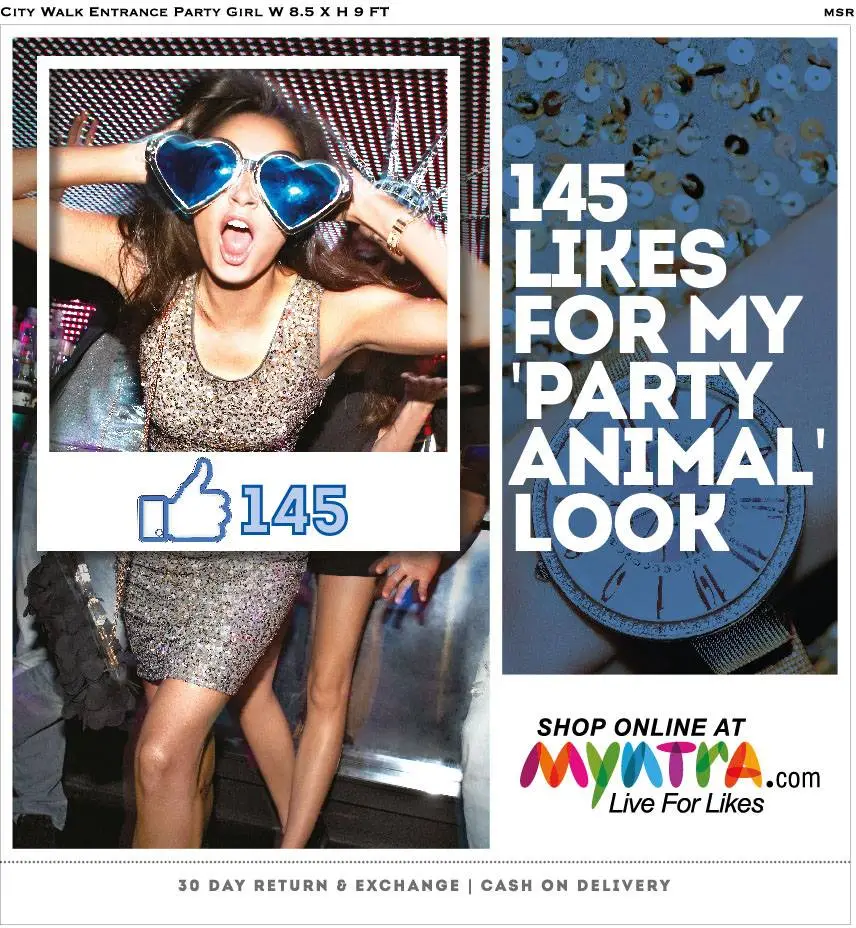Overcoming the Challenges of Advertising to Millennials: Strategies for Success
- radhika-sinha

- Apr 9, 2023
- 9 min read
Updated: Jan 11
“We think we know far more today, but as individuals, we actually know far
less. We rely on the expertise of others for almost all our needs.”
- Yuval Noah Harari

In recent years, the emergence of millennials as the largest living generation has become a topic of significant interest in the realm of business and marketing. With a projected population of 83 million people, millennials are expected to surpass baby boomers and become the most influential generation of consumers in the economy. Their distinctive traits, lifestyles, values, behavior, and attitudes set them apart from other groups, and their substantial spending power, which accounts for over 43% of the total consumer population, presents a unique challenge for businesses seeking to effectively market to this demographic.
The advent of social media and technological advancements have further complicated the task of advertising to millennials. With social media ingrained into our daily lives, companies must establish a significant online presence to connect with their target audience effectively. While traditional advertising focused on the image of the brand and long-term effects, modern advertising seeks to establish a connection with the intended audience in a brief span of time. The use of smart algorithms and data analytics can significantly influence buying behavior, making it imperative for businesses to devise effective advertising strategies to capture the attention of the millennial consumer.

In contemporary society, the proliferation of social media platforms has significantly impacted consumer behaviour. The influence of technology has made life more convenient, allowing individuals to purchase goods and services with ease and efficiency. The ubiquity of social media has become a crucial component of modern life, with a lack of presence on these platforms potentially causing individuals to be regarded with skepticism. The corporate world has recognized this phenomenon, and many companies have increased their presence on social media, actively posting and updating their pages. Millennials, who are the largest and most influential generation of consumers, are particularly active in this sphere. Studies have shown that they spend a considerable amount of time on social media, utilizing it to communicate with sellers, buyers, and advertisers. A recent study conducted by the McCarthy Group revealed that 47% of millennials consider the internet indispensable. Furthermore, they use social media to gain knowledge about their preferred brands and to determine who is promoting them. As a tech-savvy group, they take time to research and educate themselves on products in the market. Digital natives raised in a media-saturated world, millennials are the first to detect deficiencies in digital experiences. Therefore, conquering the digital space through advertising is crucial. While traditional advertising emphasizes a brand's image, range, and long-term impact, modern advertising focuses on creating a brief yet meaningful connection with the target audience. These ads are intelligently designed to utilize algorithms that can significantly influence buying behaviour.

Why are Millennials so valuable to brands and what does your audience look like?

According to Pew Research, advertisers have long considered the 18-34 age group as the most sought-after demographic. This is because this age group is mostly composed of individuals who are of working age, are less likely to have mortgages, and hence, have more disposable income. Additionally, social media-based advertisers find this demographic particularly attractive as they are generally always present on social networking media. This makes social media platforms particularly intriguing for advertisers who need to understand what millennials think, as it allows them to reach out to them through branded messaging. It is imperative to understand your target audience when developing a successful marketing strategy. To create an ideal audience profile, there are several key elements that must be considered:
Age: Age limits the audience to users between a specific age range.
Education: The type of education a user has received can provide insight into the kind of exposure they have had.
Income: Pay focuses on an audience that earns a specific income range per year. Facebook determines this income range based on a series of criteria, including self-reported job titles and profession fields.
Common Interests: Interest categories and topics can be selected to reach users who have expressed interest in a specific field or subject.
Employment: Business fields limit the focus to users who have indicated that they work in a specific field without revealing this information themselves.
Buying behavior: Purchasing behavior can include factors such as the number of touchpoints a user requires before making a decision.
Brand engagement tendencies: Engagement habits indicate whether a user prefers to click on an ad or like it on social media. It can also be as broad as "Very Often" or "Rarely."
Like any generation before it, millennials have their own unique ways of thinking and purchasing. If millennials are your target audience, it is important to understand how they differ, what they value most, and which factors influence their purchasing habits. To build a marketing strategy that effectively engages millennial consumers, it is necessary to understand what matters to them.
Millennials’ digital fluency journey is driven by purpose:
For Millennials, digital innovation is primarily valued for its ability to deliver tangible benefits, such as lower costs, free delivery, greater customization options, faster checkout, and smoother user experience. However, it should be noted that the advantage of digital technology is dependent on its ability to solve a preexisting problem. Millennials naturally evaluate the worth and advantages of new technologies based on the alternatives available to them.
While organizations have shifted their focus from physical storefronts to online platforms and from websites to mobile applications, they are now transitioning from app-first to AI-first. However, it is crucial to recognize that to effectively engage and retain Millennial customers, such transitions must be based on a foundation of direction and continuous improvement. Mere creation of applications and design of a multichannel digital presence is inadequate. Each touchpoint should solve a problem, enhance an experience, and add value to the preceding touchpoint (or existing options in the market).
In conclusion, to successfully appeal to and satisfy Millennials, every product design decision, service feature, brand perception, and customer-facing touchpoint must be purpose-driven. The following questions should be answered before the initiation of the design process and upon release of the product or service:
• What issue does it solve?
• What improvements can be immediately identified?
• How is it better, faster, and more efficient than its previous manifestation?
• How is it better, faster, and more intelligent than competitors' versions?
Failure to provide clear and unequivocal answers to these questions could result in the product or service's rejection by Millennials. Therefore, every new idea intended for Millennial buyers must have a significant and practical purpose infused into it.
Millennial buys can be driven by sentimentality:
According to a report published by Forbes, conventional advertising methods have lost their effectiveness due to the fact that 84% of millennials do not trust traditional forms of promotion. The pushy and deceptive nature of advertisements does not appeal to them, and they will go to great lengths to avoid any content that even hints at advertising, such as skipping, fast-forwarding, or blocking it altogether.
The rapid pace of change in the world is one factor driving nostalgia among millennials, but the transition from their formative years to adulthood is another key factor. While technology is often the focus of attention, it is crucial to understand how fundamental human needs influence behavior.
As a transitional generation, millennials have witnessed the world undergo a transformation from the early days of the internet to the mobile-first, AI-first world in which their children are growing up. The significance of this shift and its impact on their emotional well-being cannot be overstated. For millennials, the emotional message conveyed by an advertisement resonates more than its information content. This is because storytelling is employed rather than just focusing on the technical quality of the video.
The study identifies two types of effective advertisements: "authentic" ones that tell a complete story and "smart heart ads" that communicate a brand's values or social good. Examples of both successful and unsuccessful advertising campaigns are presented.
In conclusion, the Forbes report suggests that traditional advertising methods are no longer effective for millennials, who place greater importance on emotional messaging and storytelling. To develop effective marketing strategies for this generation, it is essential to understand their fundamental human needs. The emotional message conveyed by an advertisement is of greater significance to millennials than its informational content. The study recommends using storytelling and conveying a brand's values or social good in order to create effective advertisements.
Myntra:
The recent advertising campaign titled 'Live for Likes' by Myntra has come under scrutiny due to the promotion of a shallow and questionable lifestyle. The campaign appears to propagate the notion that it is acceptable to be fake and insincere, which is a concerning trend among the younger generation. Myntra seems to suggest that the quality of one's life is dependent on the number of likes and positive feedback received on social media platforms.
The use of false beauty marks, borrowed beverages, and even grabbing treats from children for the sake of a good selfie, all reinforce the message that it is more important to present a desirable image online, rather than living a genuine and authentic life. While there is no harm in looking presentable and sharing photos on social media platforms, the campaign's emphasis on 'likes' and positive feedback is problematic.
This trend is particularly concerning as it reinforces negative societal values and promotes superficiality over substance. Furthermore, the 'Live for Likes' campaign promotes a way of life that is unsustainable and unhealthy. It is imperative that companies such as Myntra act responsibly and refrain from propagating such values that are detrimental to society as a whole.
Dove:
The Dove campaign's central message in their 'Real Beauty' campaign was to celebrate the uniqueness and individuality of women, and to shift the focus from anxiety-inducing physical appearance to promoting self-confidence. Through the use of genuine examples, brands have the ability to create a connection with their audience that is not reliant on hard-selling or aggressive advertising techniques.
According to a study conducted by Social Media Today, 75% of consumers consider user-generated content to be more authentic. Therefore, advertisers can elicit an emotional response by incorporating real customers in a non-promotional manner to create a more relatable and engaging campaign.
By promoting authenticity and celebrating individuality, brands can create a lasting connection with their target audience. The Dove campaign serves as an example of how a shift in focus towards promoting self-confidence and positive body image can have a powerful impact on the consumers.

Millennials’ shopping ecosystem is omnichannel:
The advent of omnichannel retailing has brought about a significant shift in the retail landscape (Gao and Su, 2016). Omnichannel retailing refers to the way in which retailers and customers can engage with one another "through countless channels - websites, physical stores, kiosks, mail and catalogs, call centers, social media, mobile devices, gaming consoles, televisions, networked appliances, home services, and beyond" to conduct their shopping activities (Rigby, 2011).
At its core, omnichannel is defined as a multi-channel sales approach that provides customers with an integrated and seamless shopping experience, regardless of whether they are shopping online from a desktop or mobile device, by phone, or in a brick-and-mortar store. It is important to note the distinction between an omnichannel experience and a multi-channel experience, with the former requiring a greater level of integration and coordination. Achieving such a level of operational collaboration is no easy feat, requiring a comprehensive approach to omnichannel experience design that encompasses scripting, modeling, testing, data analysis, and operational agility aimed at creating the most seamless brand experience possible. Companies that excel in this regard include Disney, Apple, BMW, and Burberry.

Disney:
The Walt Disney Company has set a high standard for delivering a seamless and efficient customer experience through its entertainment platform. The user-friendly and mobile-responsive website serves as an excellent starting point for customers' initial interaction. Notably, the website's journey planning feature functions seamlessly on mobile devices, which is not always the case with other websites. The My Disney Experience tool allows customers to plan their entire trip, including dining reservations and securing Fast Passes. Once in the theme park, customers can use the mobile application to locate attractions and view estimated wait times. Additionally, the company has introduced the "Magic Band program" to enhance the customer experience. This multifunctional tool serves as a hotel key, photo storage device for Disney character photos, and food ordering tool. The program even integrates with the Fast Pass system to ensure that customers' trips remain uninterrupted.
Conclusion:
The current world is a diverse amalgamation of cultures, enabled by technological advancements that have created a global connectivity, rendering each part of the world to appear alike. Millennials, distinguished from older generations by their unique ways of handling finances, brand preferences, values, personalities, and general outlook, engage with brands more extensively, authentically, and differently. They also tend to seek out ways to perform tasks with minimal effort when it comes to tasks they do not particularly enjoy. Moreover, Millennials are naturally analytical and complex consumers, navigating a rich and intertwined blend of digital and analog marketplaces and experiences. Brands must view Millennial consumers not only as "customers" but as residents (or expert users) of their digital retail ecosystems, to remain relevant and competitive. The mobile-first approach has already proved to be a winning strategy for every vertical targeting Millennials.






Comments